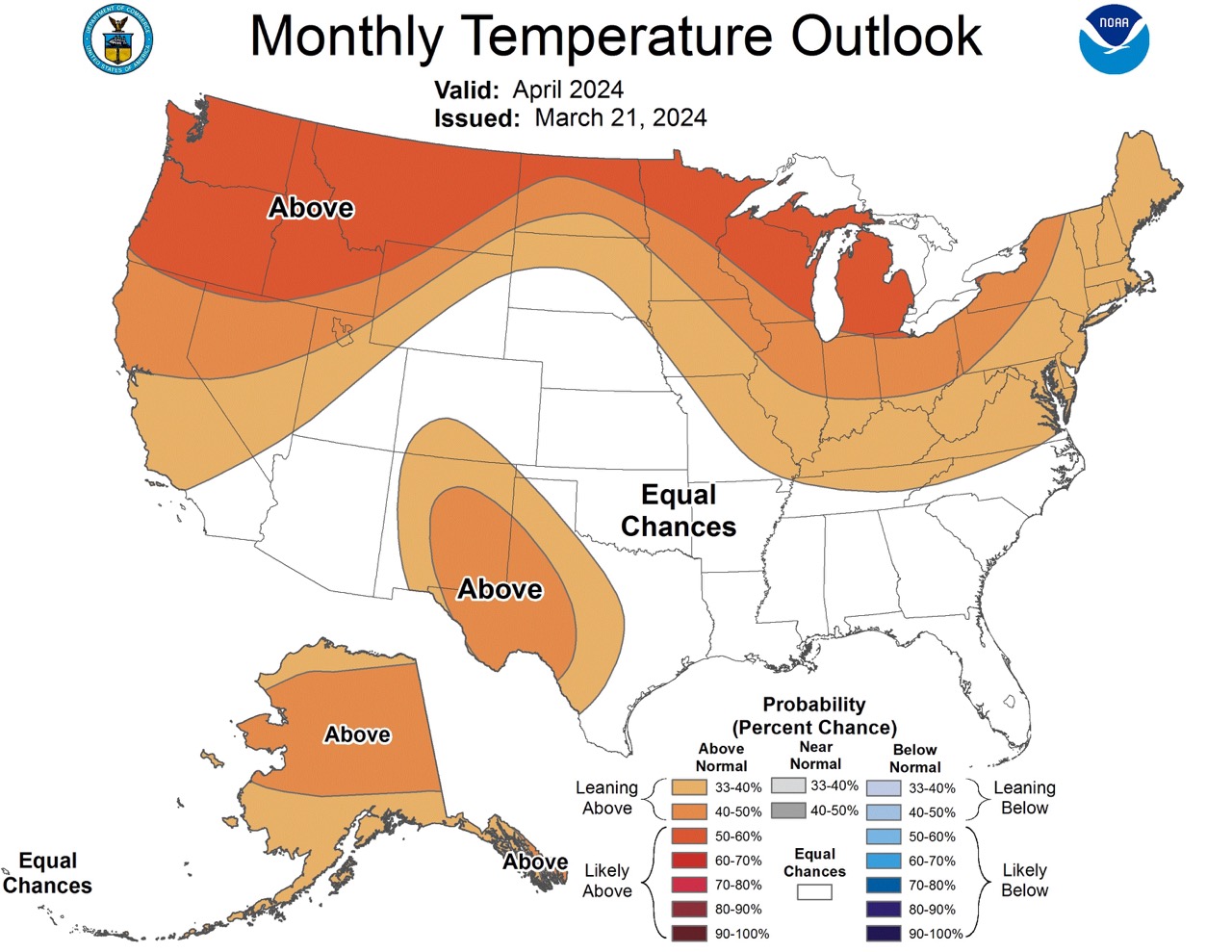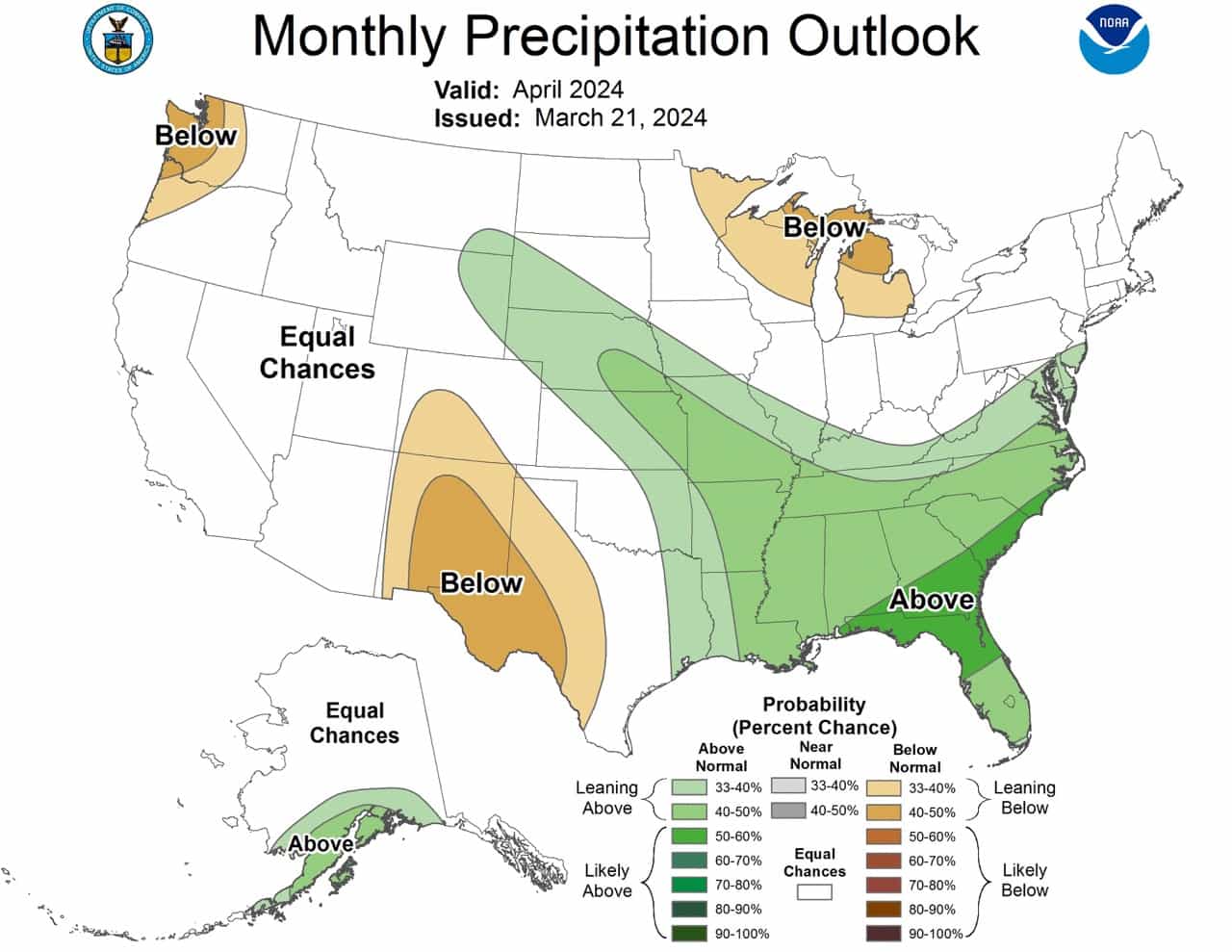

Na semana passada, a NOAA divulgou sua perspectiva para abril de 2024. Aqui está um resumo simplificado da IA da discussão sobre a previsão, com foco nos esquiadores e nas regiões com probabilidade de neve:
Perspectiva de temperatura:
- Grandes chances de temperaturas acima do normal em muitas regiões.
- Os estados da Costa Oeste em direção ao leste até as Planícies do Norte e em direção ao sudeste através do Vale Superior e Médio do Mississippi, Grandes Lagos, Vale do Ohio e partes dos Apalaches e da planície costeira do Atlântico provavelmente experimentarão temperaturas acima do normal.
- Fatores como a ferramenta Final Consolidation, a ferramenta Constructed Analog on Soil Moisture e os impactos do El Nino contribuem para essa previsão.
- Partes do Extremo Oeste, dos estados de Four Corners, do sul do Texas, do Meio Atlântico e das áreas costeiras do Nordeste também podem experimentar um calor relativo.
- Espera-se que o sul das Montanhas Rochosas e o sul das Planícies Altas tenham maiores chances de temperaturas acima do normal devido aos solos secos e ao alto ângulo de incidência do sol.
- O Alasca, com exceção das Aleutas, pode registrar temperaturas acima do normal.
Previsão de precipitação:
- Condições mais úmidas do que o normal são favorecidas a partir do sudeste do CONUS em direção ao noroeste até o centro-norte das Planícies Altas.
- Precipitação abaixo do normal é esperada para a região dos Grandes Lagos Superiores devido à baixa profundidade da neve, baixa umidade do solo e impactos do El Niño.
- O sudoeste do Colorado, o Novo México e a maior parte do oeste do Texas podem apresentar precipitação abaixo do normal devido à baixa umidade do solo e ao alto ângulo de incidência do sol.
- Partes do noroeste também podem registrar precipitação abaixo do normal.
- No Alasca, há diferenças nas previsões, mas há uma grande chance de precipitação acima do normal na parte sul, incluindo a Península do Alasca.
O que isso significa para os esquiadores?
- Os esquiadores dos estados da costa oeste, das planícies do norte e de partes do meio-oeste devem esperar temperaturas acima do normal, o que pode afetar as condições da neve.
- As Planícies Altas do Centro-Norte podem ter condições mais úmidas do que o normal, o que poderia beneficiar os resorts de esqui nessas áreas.
- Os esquiadores da região dos Grandes Lagos Superiores podem experimentar precipitação abaixo do normal, o que pode afetar negativamente o acúmulo de neve e as condições de esqui.
- O sudoeste do Colorado, o Novo México e o oeste do Texas também podem registrar precipitação abaixo do normal, afetando as áreas de esqui nessas regiões.
- Os esquiadores no Alasca, especialmente na parte sul, podem experimentar precipitação acima do normal, o que pode aumentar as oportunidades de esquiar nessas áreas.


Aqui está o discussão completa da NOAA:
30-DAY OUTLOOK DISCUSSION FOR APRIL 2024 The April 2024 monthly temperature and precipitation outlooks are based on various climate factors (such as ENSO and to some degree, the Madden-Julian Oscillation (MJO)), boundary conditions (snow depth and soil moisture), dynamical and statistical model guidance, and historical temperature and precipitation trends . Sea-surface temperature (SST) anomalies across the central and eastern equatorial Pacific have significantly decreased during the past few weeks, and a relatively small extent of anomalously cool water has appeared over the eastern Pacific related to the upwelling phase of an oceanic Kelvin wave. Cooler-than-average subsurface temperatures have developed over much of the eastern Pacific. By mid-March, enhanced trade winds have returned to a large portion of the equatorial Pacific. All these factors are consistent with a rapidly weakening El Nino, which has been in place for just over one year. El Nino is forecast to transition to ENSO-neutral during the April-May-June (AMJ) season. However, El Nino impacts are expected to linger well into the month of April across the United States, and these expected impacts were considered in the construction of the April outlook. Another climate factor to consider is the currently robust MJO. The enhanced convective phase of the MJO is located over the Western Pacific (Phase 7 in RMM space), and the suppressed phase of the MJO is located over the Indian Ocean (Phases 2 and 3 in RMM space). Model forecasts of the MJO index propagate the MJO signal into the Western Hemisphere over the next two weeks. Within the first week of April, lagged MJO composites for Phase 7 favor anomalously cool temperatures over at least the central third of the contiguous U.S. (CONUS). In addition to the climate factors noted above, there is an extensive area of anomalously low snow depth from Montana eastward across the Northern Great Plains, Great Lakes region, and Northeast. From eastern Montana across the Northern Plains snow depth departures are generally 8 inches or less, though in the vicinity of Great Falls, Montana, snow depth departures range from 2-3 feet (locally greater) below normal. From the Upper Mississippi Valley eastward across the Great Lakes and New England snow depth ranges anywhere from 8-30 inches below normal. Unusually low snow depth means less water will be available for staggered release into soils during the beginning weeks of the growing season. Much of this region is also experiencing relatively low soil moisture values. The exception is the Northeast, where recent precipitation has resulted in ranked soil moisture percentiles in excess of the 95th percentile. For the April temperature outlook, there are elevated chances for above-normal temperatures from most of the West Coast states eastward and northeastward into the Northern Plains, continuing eastward and now southeastward across the Upper and Middle Mississippi Valley, Great Lakes region, Ohio Valley and neighboring portions of Tennessee, most of the Appalachians, and the Atlantic coastal plain from Maine to northern North Carolina. The favored above-normal temperatures are generally supported by the Final Consolidation tool (Final-CON) which skill-weights a consolidation of dynamical models (NMME-CON) and a consolidation of statistical models (Stat-CON). These temperatures are also generally supported by the Constructed Analog on Soil Moisture Tool (CA-SMT), and to a lesser degree the International Multi-Model Ensemble (IMME, also referred to as C3S or Copernicus), CFS, calibrated NMME (PAC), and GFDL SPEAR models. Most of the favored above-normal temperatures were derived from dynamical model guidance rather than statistical model guidance. Expected lagged El Nino impacts also played a role in this forecast, as well as above-normal SSTs along the West Coast. The boundary conditions noted earlier played a significant role in the temperature forecast from Montana eastward across the Great Lakes and Northeast. The probabilities favoring above-normal temperatures across New England and eastern New York state were tempered by anomalously high soil moisture values. The 15-year Optimal Climate Normals (OCN) temperature tool, a proxy to the last 15 years of historical temperature trends, favored relative warmth across portions of the Far West, Four Corners states, southern Texas, and the Mid-Atlantic and Northeast coastal plain. There are increased chances for above-normal temperatures over the southern Rockies and southern High Plains, associated with anomalously dry soils, the three CON tools (noted above), and a high sun-angle. Most model guidance supported above-normal temperature chances for most of Alaska, with the exception of the Aleutians where Equal Chances (EC) of below, near, and above-normal monthly mean temperatures are favored. The April precipitation outlook is based on the same climate factors, boundary conditions, and model guidance as the April temperature outlook. Wetter-than-normal conditions are favored from approximately the southeastern quadrant of the CONUS northwestward into the north-central High Plains. This is generally consistent with the Final and NMME CONs, uncalibrated NMME, IMME, historical precipitation trends , and lagged El Nino impacts. Well below-normal snow depth, anomalously low soil moisture, and expected lagged El Nino impacts favor below-normal precipitation for the Upper Great Lakes region. Anomalously low soil moisture, high sun-angle, and guidance from the Final and Stat CONs favor below-normal precipitation across southwestern Colorado, New Mexico, and most of West Texas. Below -normal precipitation is also favored for parts of the Northwest, based on model support and lagged El Nino impacts. In Alaska, there were significant differences in the precipitation forecasts, though the IMME, GFDL SPEAR, and Canadian CanCM4i models supported an elevated chance of above-normal precipitation across the southern part of the state, including the Alaska Peninsula.